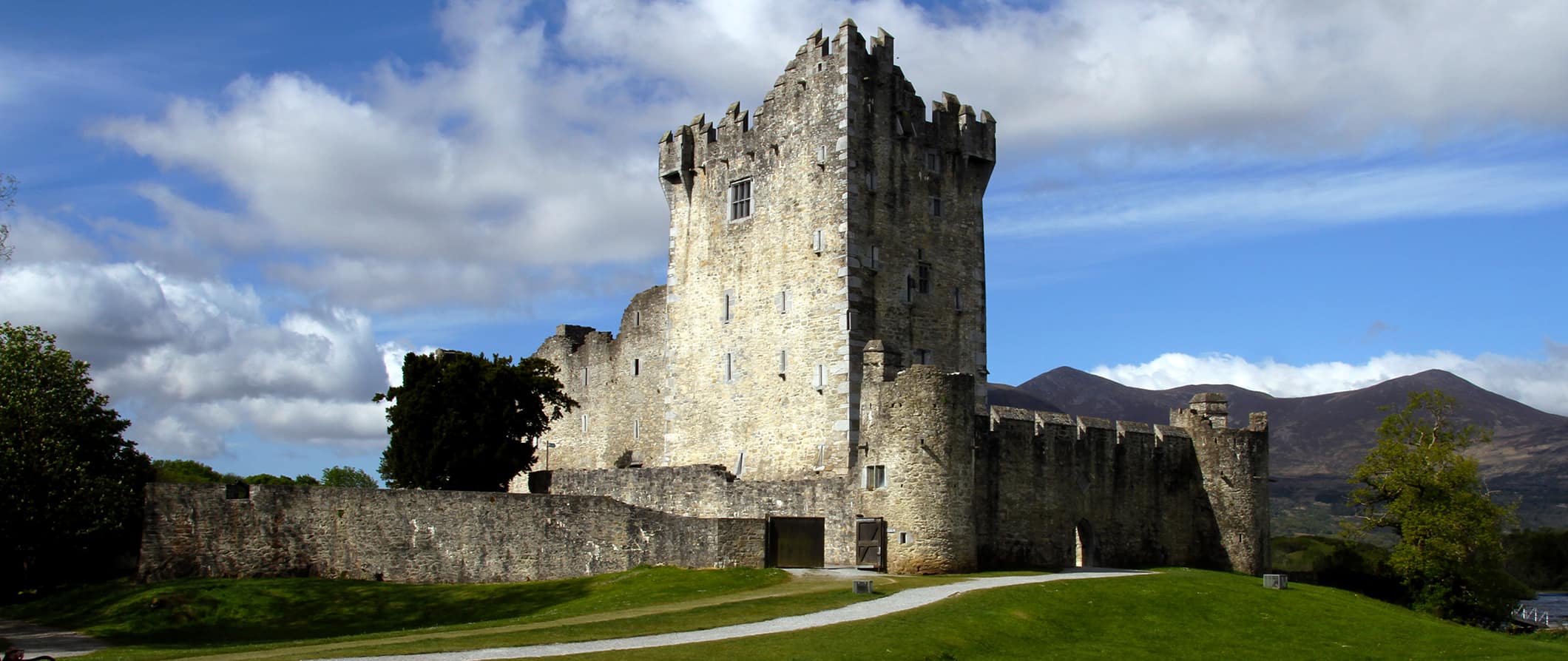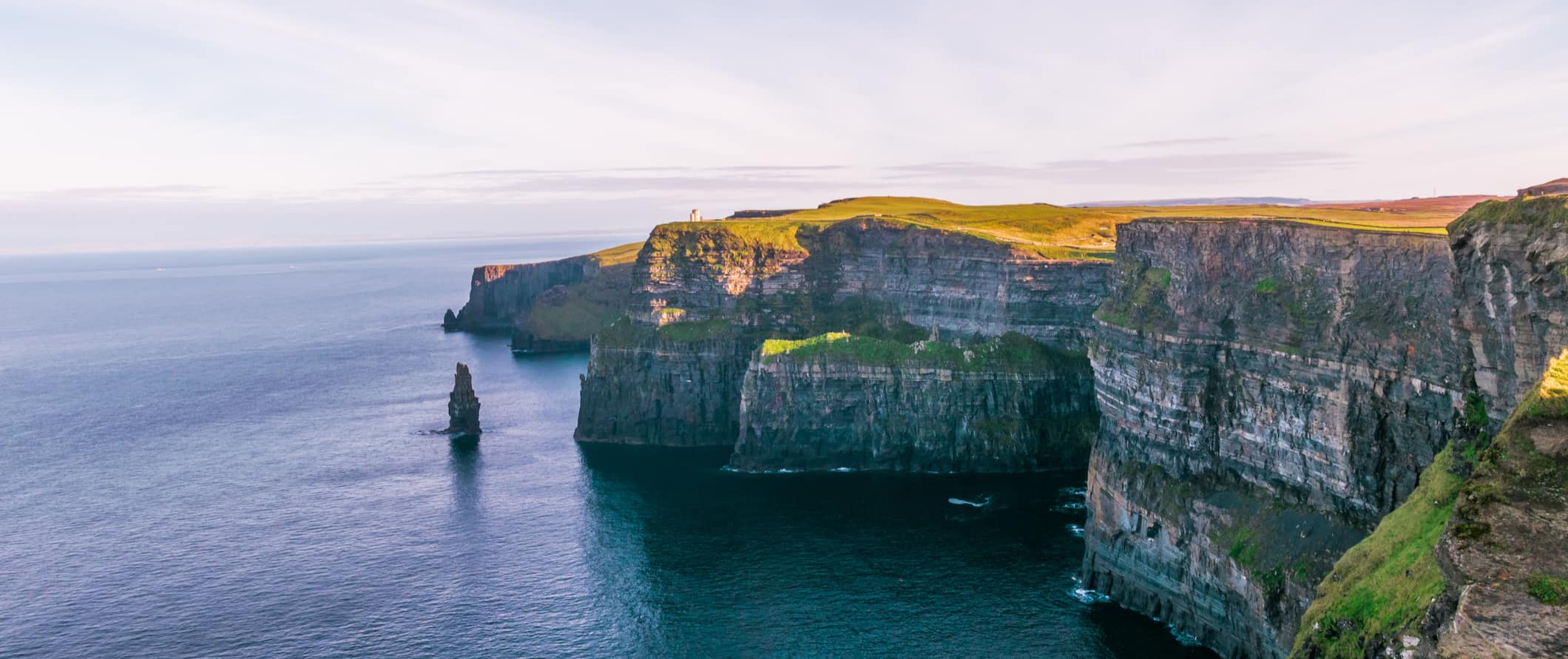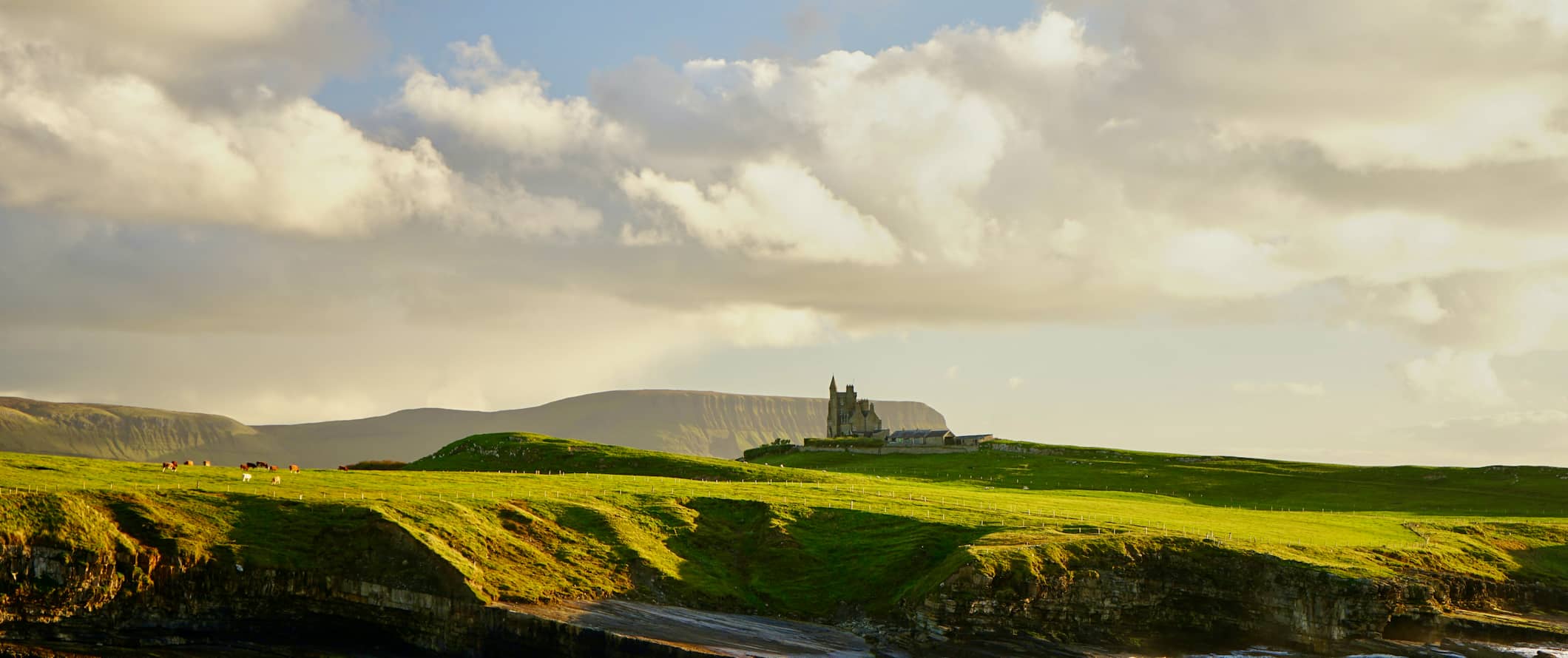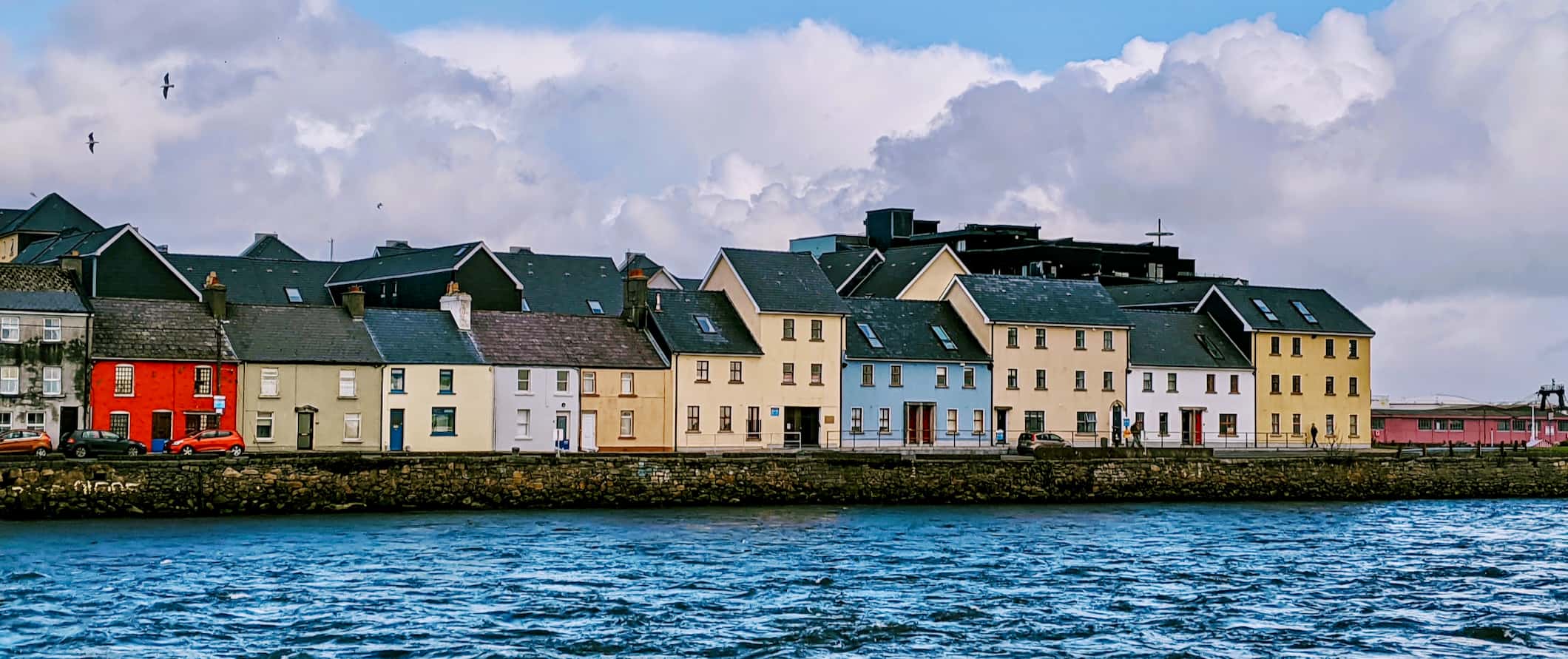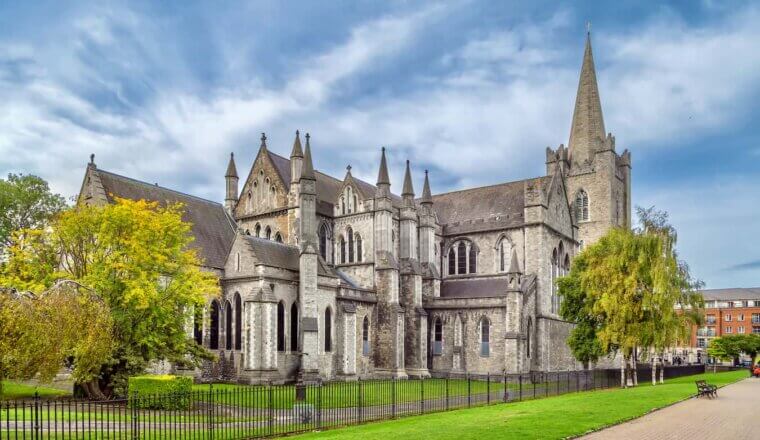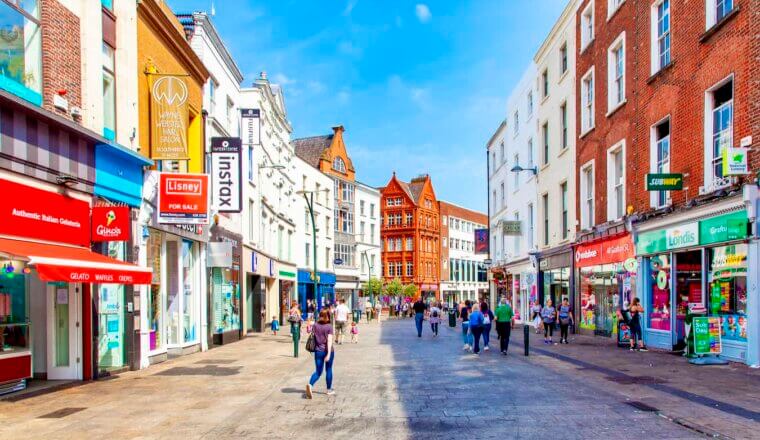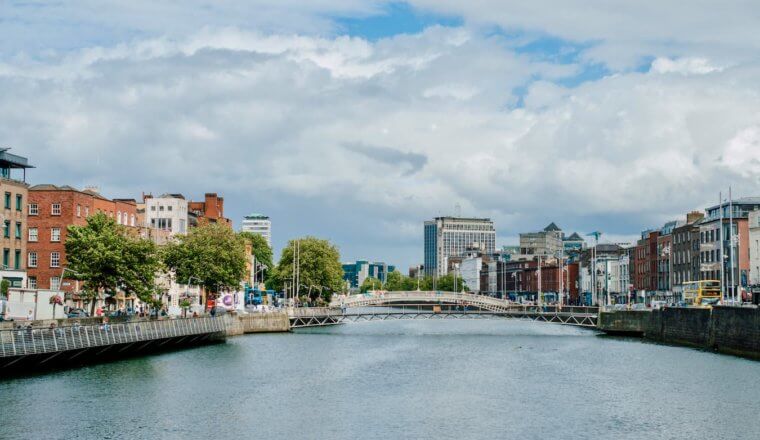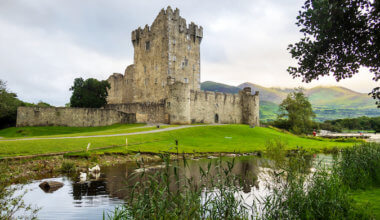I love backpacking around Ireland for the rolling green hills, historic castles, beautiful seaside landscapes, and all the Guinness and Jameson you can drink. The Emerald Isle is an enchanting postcard-perfect destination with tons to see and do whether you’re in the Dublin for a long weekend or plan to spend several weeks backpacking across the country.
While millions of people visit Ireland each year, most of them stick to Dublin, see the main sights, drink a few pints, and head on their way.
But there is so much more to traveling here — especially if you have time to rent a car and get off the beaten path. Ireland is the perfect road trip country. Seriously. Drive around! And make plenty of stops along the way. You’ll find cool little towns and tons of ruins and castles, some of which are rumored to be haunted.
Anyone who has spent time in Ireland will agree that it’s a magical land full of wonder, history, nature and plenty of post-travel tales. No one ever leaves Ireland unhappy.
This Ireland travel guide can help you make the most out of your time on the Emerald Isle and ensure you have fun without breaking the bank.
Table of Contents
Click Here for City Guides
Top 5 Things to See and Do in Ireland
1. Have fun in Dublin
Dublin is synonymous with fun. The capital of the Republic of Ireland and its largest city, Dublin offers so much to explore. The city’s 18th century Georgian architecture is some of the best in Europe. Take a walk through history with a visit to Dublin Castle, be awe-struck by St. Patrick’s Cathedral’s medieval architecture, which was completed in 1260, tour Trinity College for a look inside one of Europe’s oldest and most prestigious educational institutions and while you’re there check out the iconic Book of Kells (an illuminated manuscript) from 800 CE. Literature lovers can stroll around the city on a self-guided literary tour. Fans of Ireland’s most famous export (Guinness) will find no shortage of pubs that claim to pour the city’s best pint but go directly to the source with a tour of the Guinness Storehouse (admission starts at 24 EUR). At night there’s bountiful live music in small pubs or larger clubs, one of the many ways to experience Irish“craic,” the nation’s word for that fun feeling you have with friends.
2. Admire the Cliffs of Moher
The Cliffs of Moher stretch for 8 kilometers (5 miles) along the Atlantic coast in County Clare. They offer some of the most incredible views in all of Ireland. On a clear day you can see as far as Aran Islands in one direction, and Galway Bay in the other. The cliff’s name comes from the Gaelic word Mothar which means “ruins of a fort” and O’Brien’s tower, which now sits atop the cliffs, was constructed using the original fort’s stone in 1835. The cliffs reach a height of 214 meters (702 feet) and are home to a wide variety of birds. If you visit in late spring, you’ll probably see a colony of colorful puffins. Save this activity for a sunny day because there isn’t much to see when the cliffs are shrouded in Ireland’s famous mist. Admission is 10 EUR. If you’re short on time, take a day tour (they usually have a few stops, including Galway). Coming from Galway, it’s about a 90-minute drive. From Dublin, it’s more than three hours by car or bus.
3. See the Giant’s Causeway
Cross the border into Northern Ireland to visit the famous Giant’s Causeway, a natural geological phenomenon composed of over 40,000 basalt pillars that look like a staircase for giants. They formed between 50 and 60 million years ago during the Paleocene Epoch due to intense volcanic activity in the area. The tallest of the columns are around 12 meters (39 feet) high and 28 meters (92 feet) thick. The name is also said to have come from an Irish legend where a giant named Finn McCool created a path across the Irish Sea face down his arch enemy, the Scottish giant Benandonner. The pillars are a UNESCO World Heritage Site and named one of the top four natural wonders in The United Kingdom. It’s a protected nature reserve, however you can walk across the rocks using one of the four marked trails. Maps are available at the visitor center. Admission is free, but if you arrive by car you need to pay for parking, though it includes a guided tour.
4. Drive along the Ring of Kerry
This is one of the most well-trodden tourist trails in Ireland for a reason. Stretching almost 200 kilometers (125 miles), the Ring of Kerry is a scenic route that loops around the Iveragh Peninsula on the west coast of Ireland. It’s the ultimate Irish road trip along winding coastal roads, lush green pastures, and rolling hills. You’ll pass by lakes, small mountains, historical forts, and an ancient druid stone circle. Stop for a few of the highlights along the route. Ross Castle, built in the 15th century is open to guided tours. Lough Leane consists of a series of small lakes surrounded by dense forest and ancient castle ruins scattered in the area. You could spend the whole day in Killarney National Park with its lakes, walking trails and waterfalls. Staigue stone fort is a circular stone ruin likely built in the Iron Age. Driving the entire route takes 3.5 to 4 hours nonstop, but plan for an all-day adventure with stops. If you don’t have a vehicle you can take a day tour from Killarney. And if you want to challenge yourself, trek the 215-kilometer (135-mile) Kerry Way on foot!
5. Wander Galway
Galway is a hub for students and musicians and has a younger vibe to it. There’s a lively nightlife scene here and tons of buskers in the Latin Quarter. It’s one of the best places in Ireland to see live music. During the summer months, this seaside city on the west coast of Ireland is a popular place for swimming. Head to Salthill Beaches on Galway Bay for soft sand. Here you’ll also find a gorgeous waterfront walkway called the Salthill Promenade where you can take in the local pace of life. Further north is Silverstrand Beach that’s famous for rocky cliffs and shallow waters along the pebble beach. Galway Cathedral is the youngest of Europe’s great stone cathedrals and is full of unique religious art. There’s also a mosaic of US President John F. Kennedy. Don’t skip this city!
Other Things to See and Do in Ireland
1. Spend time in Cork
Cork is a buzzing city nestled on Ireland’s southern coast. Originally a maritime hub, Cork is now a cosmopolitan university city filled with cheap eats and a lively nightlife. Head to the English Market in the morning for baked goods or fresh produce – it’s one of the oldest covered markets in Europe. Joind the hundreds of thousands of people that come here each year to kiss the Blarney Stone for good luck. There’s plenty of opportunity to hike around Gougane Barra, and to enjoy the coastal landscape around Mizen Head where you’ll find a suspension bridge with views of towering cliffs and the Atlantic. Surfing and whale watching are also popular here as minke whales, fin whales, and humpback whales are commonly seen along the coast (expect to pay around 55 EUR for a whale watching tour).
2. Party on St. Patrick’s Day
St. Patrick is Ireland’s patron saint. As the legend goes, he drove all the snakes out of the country. Whether you believe the legend or not, this is the biggest party of the year in which everyone is Irish. The biggest parade takes place in Dublin. It’s one of the biggest parties in the world so be sure to book your stay in advance as everything sells out quickly!
3. Kiss the Blarney Stone
Blarney Castle sits just outside Cork. Built in the 15th century, visitors flock here to see the Stone, which is made of Carboniferous limestone and is built into the castle itself. The stone was set in 1446 and it is said to bestow eloquence on all those who kiss it (“blarney” has come to mean “flattering speech”). Expect a long line during summer months or other peak travel times. Admission is 18 EUR (16 EUR if you buy your ticket online).
4. See historic castles
Ireland is steeped in history and the entire country is covered in castles (there are some 30,000 castles and castle ruins here). For fans of ruins, don’t miss the crumbling charm of Dunluce Castle or the majestic half-standing Rock of Cashel with soaring archways. The impeccably preserved Cahir Castle in Tipperary is also one of the largest. If it’s within your budget, attend a medieval banquet at the Bunratty Castle in Clare or book a room at the beautifully restored Ashford Castle in County Mayo. If you’re just on a quick trip to Dublin, take the 30-minute train outside the city to Malahide Castle. If you plan on visiting a lot of castles, get the Heritage Card. It’s 40 EUR and provides free entry into tons of Ireland’s castles and will save you a ton.
5. Hike in Connemara
This national park in County Galway covers more than 30 square kilometers (12 square miles), offering scenic views and great hiking. Most people come here for hiking and forest bike riding, though there are a few castles within the park as well as an old mining area and a heritage and history center. There are also tons of wildlife to spot, such as rabbits, foxes, stoats, hawks, falcons, and herds of Connemara ponies. There are several trails that range from short loops on flat land, to more strenuous mixed-terrain paths that offer elevated views. Admission is free and day tours are available. There are no campsites, but wild camping is allowed – just come prepared with all the necessary gear.
6. Wander the John F. Kennedy Arboretum
Located in County Wexford 30 minutes west of Waterford, this garden is home to over 4,500 species of trees and shrubs. There are several tea rooms, a visitors’ center, and a picnic area here too. The arboretum gets its name from the fact that JFK’s great-grandfather was born nearby, and the President visited in 1963. The arboretum opened five years later in his honor, paid for by donations from Irish Americans. Admission is free.
7. Explore the Aran Islands
Located in Galway Bay, only 1,200 people call these islands home. Here, Irish is the primary language (though many also speak English). You can get around by bus, bike, or carriage as you see the various heritage sights, ruins, castles, and scenic landscapes. Tobar Einne and O’Brien’s Castle are two of the most popular attractions. On Inis More (Inishmore) you can visit Dun Aengus, a Bronze Age and Iron Age fort hugging the coast, and the Seven Churches ruins featuring a large complex of partially-preserved structures and graveyards with traditional Irish Cross stones. Inis Mor is the largest of the islands and the most accessible. You can take a bus from Galway and hop on the ferry from Rossaveal (30 EUR).
8. Go back in time at Ulster Museum
Head into Northern Ireland for a day trip and visit the Ulster Museum. It has a vast and diverse collection of all kinds of artifacts and artwork, ranging from rare paintings, archeology and local history to wildlife and dinosaurs to relics from the Spanish Armada and Egyptian mummies. The museum is located within a large botanical garden. It’s the biggest museum in Northern Ireland. Admission is free. You can reach Belfast from Dublin in less than two hours by car.
9. See Newgrange
Located 45 minutes north of Dublin by car, Newgrange is a prehistoric burial mound that dates back over 5,200 years (which makes it older than both Stonehenge and the Great Pyramids). Human remains, as well as other artifacts, were found in the massive tomb, which is composed of a ring of stone topped by earth. Inside are several burial chambers and passageways. Every year on the Winter Solstice, a beam of light streams down the perfectly aligned entrance passage to illuminate the interior chamber. Admission is 10 EUR.
10. Visit Killarney
Killarney is one of Ireland’s most popular tourist destinations thanks to its undeniable medieval charm. Located in the southwest of the country, you can visit Muckross Abbey (a 15th-century Franciscan friary on rolling green hills inside Killarney National Park), Ross Castle (which also dates to the 15th century), or wander around the town itself, which looks like a quaint village with small shops and colorful buildings. Some of the other best things to do in Killarney include renting a bike to cycle around Killarney National Park or relaxing at one of the nearby lakes. This is also the traditional starting point for exploring the Ring of Kerry.
11. Learn about (and sample some) whiskey
If you’re a whiskey fan, take a tour of the Jameson Distillery in Cork and see how Irish whiskey is made. Jameson is one of the oldest whiskey companies in Ireland and is the best-selling Irish whiskey in the world. On a tour, you’ll visit the main buildings and learn how their whiskey is made, what sets Irish whiskey apart from other types, and how the company got started as a small family distillery. There are several different tours, but the Jameson Distillery Experience tour is the best value at 23 EUR. It’s 75-minutes and includes a whiskey sample
For more information on specific cities in Ireland, check out these guides:
Ireland Travel Costs
Accommodation – There’s no shortage of choices on where to stay in Ireland. Hostels are common across the country, especially in cities, and you’ll find privately run cozy hostels and larger chains. For those biking or backpacking across the country, you’re in luck. There are a number of hostels and budget hotels in rural areas that see a lot of active travelers on foot or bike. There’s also a wide variety of mid-price chains across Ireland if you’d like to upgrade for a few nights. Summer is peak season, so book ahead.
Prices average 28-40 EUR per night for a hostel dorm room with 4-8 beds. You can find private rooms that sleep two ranging from 60-100 EUR. Free Wi-Fi is standard and most hostels also include self-catering facilities.
For those traveling with a tent, a basic plot for two people without electricity can be found for around 12-15 EUR per night.
Budget hotels average 90-130 EUR. Free Wi-Fi is standard and some also include an Irish breakfast (toast, eggs, sausage, and beans).
Airbnb is available all around the country with private rooms starting at 40 EUR per night. Full apartments with a kitchen average of 100 EUR per night. Expect to pay double (or more) if you don’t book in advance.
Food – Ireland is very much a “meat and potatoes” country. Potatoes have been a common staple since the 18th century, along with seafood (it’s an island after all!). Cod, salmon, and oysters are some of the most popular seafood options, with other staple dishes being shepherd’s pie, black pudding, bacon and cabbage, fish and chips, and meat stews. You’ll find plenty of budget eats and street food, especially in larger urban areas, including takeaway fish and chips and a wide range of food trucks in Dublin. Vegan meals are bit harder to find. There are a few choices for budget to moderately-priced restaurants that offer vegan and vegetarian fare in Dublin, Cork, and Galway. There are also more modern Irish restaurants popping up, especially in Dublin, but expect to pay up.
A traditional meal costs around 15 EUR. For a multi-course meal with a drink, expect to pay at least 30 EUR. Fast food (think McDonald’s) starts at 9 EUR for a combo meal.
Pizza costs 7-10 EUR for a medium while Chinese food costs around 9-12 EUR for a main dish. Fish and chips can be found for as little as 6 EUR.
Beer is around 5 EUR while a latte/cappuccino is 3.50 EUR. Bottled water is 1.50 EUR.
If you want to cook your meals, expect to pay 40-60 EUR per week for groceries that include basic staples like pasta, rice, produce, and some meat.
Backpacking Ireland Suggested Budgets
On a backpacking budget of 65 EUR per day, you can stay in a hostel dorm, cook all your meals, limit your drinking, take public transportation, and do free and cheap activities like free walking tours or visiting castles. If you plan on drinking, add 5-15 EUR per day to your budget.
On a mid-range budget of 140 EUR per day, you can stay in a private hostel room or Airbnb, eat out for most meals at cheap fast food places, enjoy a couple of drinks, take the occasional taxi, and do more paid activities like visiting the Cliffs of Moher.
On a “luxury” budget of at least 240 EUR per day, you can stay in a hotel, eat out anywhere you want, drink more, rent a car for day trips, and do as many tours and excursions as you want. This is just the ground floor for luxury though. The sky is the limit!
Ireland Travel Guide: Money-Saving Tips
It’s easy to break the bank in Ireland as all those pub visits can add up fast. To help you save without sacrificing your trip, here are some money-saving tips for Ireland:
- Ask for student discounts – A valid student ID can get you discounts of up to 50% on many attractions, museums, and buses throughout the country. If you have a valid student ID, always ask for discounts. Take note, these discounts most often apply to anyone under 26 with a student ID.
- Drink less – Ireland’s strong pub culture can hit your wallet hard. Temper the cost by visiting happy hours, drinking at home, or skipping drinks altogether.
- Eat the pub food – Eat at the pubs for hearty local Irish food that won’t destroy your wallet. It’s not healthy, but it’s affordable.
- Get an OPW Heritage Card – If you love to tour heritage sites, pick up this card. It provides free access to most of the castles throughout the country. The card is 40 EUR.
- Stay with a local – Couchsurfing connects you with locals who can give you a free place and show you around their city. You not only get to save money but you make a new friend in the process!
- Eat early – Many restaurants have budget dinner options if you eat early (usually before 6pm). You won’t have as much variety since it’s a set menu, but it will be much cheaper!
- Cook your meals – Staying in a hostel will help you make new travel buddies, and they’ll likely have a kitchen. The biggest grocery chain is Tesco, which has large super stores and smaller city shops for basics. Don’t snooze on Aldi or Lidl. These discount grocers carry everything you’d need for a meal, and have aisles with deeply-discounted merch.
- Take free walking tour – Some of the bigger cities in Ireland (like Dublin and Galway) have free walking tours available. They’re the best way to see the main highlights on a budget. Just remember to tip your guide at the end!
- Bring a water bottle – The tap water here is safe to drink so bring a reusable water bottle to save money and reduce your plastic use. LifeStraw is my go-to brand as their bottles have built-in filters to ensure your water is always clean and safe.
Where to Stay in Ireland
Ireland has plenty of fun, social hostels. Here are my suggested places to stay if you’re on a budget:
- Generator Hostel (Dublin)
- Jacobs Inn (Dublin)
- Galway City Hostel (Galway)
- The Nest Boutique Hostel (Galway)
- Sheilas Cork Hostel (Cork)
- An Oige Youth Hostel (Killarney)
- The Hideout Hostel (Dingle)
How to Get Around Ireland
Public transportation – Public transportation in Ireland is clean, safe, and reliable. Bus trips around Dublin cost about 3 EUR while Galway tickets are 2.20 EUR and tickets in Belfast are 1.60 GBP if you head into Northern Ireland.
With a LEAP card (a card you can top up to use on the country’s public transportation), you can use all public transportation options for reduced prices (up to 31% off compared to cash tickets). You can even use it for DublinBikes self-service bicycle rentals.
A day pass on public transportation costs 8-10 EUR.
Bus – Ireland is a small island so you won’t find too many routes that are longer than a few hours. That means that prices are pretty reasonable. The 2.5-hour trip from Dublin to Belfast in Northern Ireland costs around 20 EUR. A bus from Dublin to Galway takes about 2.5 hours and costs between 12-25 EUR.
Bus Éireann is the main coach service, while Translink serves the North (and includes Ulsterbus and Goldline). You can search their website for the best deals and for route schedules. If you book early, you’ll get the lowest ticket prices.
There’s a really handy journey planning website that can help you plan your route (but you can’t buy tickets there).
Train – Irish Rail is the main train service provider in Ireland. While the train is more expensive than the bus, it’s still quite affordable. Cork to Dublin takes around 2.5 hours and costs 20-30 EUR while Galway to Dublin costs 17-25 EUR and takes about the same amount of time.
Bus & train passes – Ireland has several rail and bus passes that might make sense for you depending on your itinerary and budget:
- Irish Explorer – Five days of unlimited Irish Rail travel within 15 consecutive days for 128 EUR.
- Sunday Day Tracker – This deal is for one day of unlimited travel (Sundays only) on Translink buses and trains in the North. It costs 3.50 EUR
- Trekker Four Day – Unlimited travel on Irish Rail within a four-day period for 88 EUR.
Car Rental – Renting a car in Ireland is affordable, with prices starting around 25 EUR per day for a multi-day rental. Renting a car is the best way to get around the country too. Renters need to be at least 21 years old. Just keep in mind that most rentals are manuals and that they drive on the left.
For the best rental car deals, use Discover Cars. You can get a free quote using this widget:
Hitchhiking – Hitchhiking in Ireland is very safe, and it’s not uncommon to spot backpackers on the side of the road. It can be difficult in the countryside where there is minimal traffic. It is not often easy to get a ride, but it’s also not impossible. Hitchwiki is the best website for additional hitchhiking info. Always take normal precautions when grabbing a ride.
When to Go to Ireland
Ireland’s temperate climate makes it a good destination to visit year-round, keeping in mind that you’re guaranteed to encounter rain no matter when you visit.
The summer months (June-August) are the warmest and the sunniest so this is when the country is at its liveliest. Keep in mind that this is peak season so you’ll compete for accommodation in the larger cities. And lines will be longer for attractions like museums or castles. Prices are a little inflated too. Average temperatures hover between 13-20°C (56-68°F) but can climb to 25°C (77°F) or more. Be warned, if you go for a swim at one of the beaches, the water will be cold. Ocean temperatures won’t be over 18°C (65°F) on a warm day! They’ll likely be a little cooler.
Winters can be drizzly with short daylight hours, but temperatures rarely fall below freezing. Dress warmly and be prepared for lots of indoor activities if you visit during this time. If you visit around Christmas, the festive lights and Christmas markets make for a warmer atmosphere. The pubs will be more celebratory, too.
Saint Patrick’s Day in March is huge all around the country. During this time, hostels and hotels fill up quickly, and prices spike. Temperatures are still mild and Ireland is just as beautiful as ever but you’ll need to book your accommodation in advance.
Overall, the shoulder seasons (March-May and September-October) are my favorite times to visit. Aside from St. Patrick’s Day, you’ll find prices to be a little lower and the country to be less busy. The weather is decent enough for exploring too. Just bring an umbrella! September is an especially fun time to see Ireland. The weather is still warm-ish but the larger crowds, especially those traveling with children, have cleared out. You might feel like you’re the only tourist at a castle or on a hike.
How to Stay Safe in Ireland
Ireland is very safe and the risk of experiencing violent crime here is low. That said, scams and pick-pocketing can occur in high-traffic areas, especially around tourist attractions like Temple Bar in Dublin. Always keep your valuables secure and out of reach just to be safe.
If you rent a car, don’t leave valuables inside the vehicle overnight. Break-ins are rare but it’s always better to be safe than sorry.
Be alert when driving, especially on twisty country roads or roundabouts (traffic circles). Most roads are paved and in good condition, but if you are used to driving on the other side (they drive on the left in Ireland) a steep curve may surprise you.
Solo female travelers should generally feel safe here, however, the standard precautions apply (never leave your drink unattended at the bar, don’t walk home alone intoxicated, or venture into unknown areas after dark, etc.). For tips, use one of the many solo female travel blogs on the web as they’ll be able to provide better advice than I can.
When camping, understand designated sites from wild spots. Wild camping is generally accepted, but keep in mind that much of the remote land you see is probably private property. Camp sites are well kept, but when opting for parks or remote areas, you may not have cell service.
Scams here are rare, but if you’re worried about getting ripped off you can read about common travel scams to avoid here.
If you do experience an emergency, dial 112 or 999 for assistance.
The most important piece of advice I can offer is to purchase good travel insurance. Travel insurance will protect you against illness, injury, theft, and cancellations. It’s comprehensive protection in case anything goes wrong. I never go on a trip without it as I’ve had to use it many times in the past. You can use the widget below to find the policy right for you:
Ireland Travel Guide: The Best Booking Resources
These are my favorite companies to use when I travel. They consistently have the best deals, offer world-class customer service and great value, and overall, are better than their competitors. They are the companies I use the most and are always the starting point in my search for travel deals.
- Skyscanner – Skyscanner is my favorite flight search engine. They search small websites and budget airlines that larger search sites tend to miss. They are hands down the number one place to start.
- Hostelworld – This is the best hostel accommodation site out there with the largest inventory, best search interface, and widest availability.
- Booking.com – The best all around booking site that constantly provides the cheapest and lowest rates. They have the widest selection of budget accommodation. In all my tests, they’ve always had the cheapest rates out of all the booking websites.
- HostelPass – This new card gives you up to 20% off hostels throughout Europe. It’s a great way to save money. They’re constantly adding new hostels too. I’ve always wanted something like this and glad it finallt exists.
- Get Your Guide – Get Your Guide is a huge online marketplace for tours and excursions. They have tons of tour options available in cities all around the world, including everything from cooking classes, walking tours, street art lessons, and more!
- The Man in Seat 61 – This website is the ultimate guide to train travel anywhere in the world. They have the most comprehensive information on routes, times, prices, and train conditions. If you are planning a long train journey or some epic train trip, consult this site.
- Trainline – When you’re ready to book your train tickets, use this site. It streamlines the process of booking trains around Europe.
- Rome2Rio – This website allows you to see how to get from point A to point B the best and cheapest way possible. It will give you all the bus, train, plane, or boat routes that can get you there as well as how much they cost.
- FlixBus – Flixbus has routes between 20 European countries with prices starting as low 5 EUR! Their buses include WiFi, electrical outlets, a free checked bag.
- SafetyWing – Safety Wing offers convenient and affordable plans tailored to digital nomads and long-term travelers. They have cheap monthly plans, great customer service, and an easy-to-use claims process that makes it perfect for those on the road.
- LifeStraw – My go-to company for reusable water bottles with built-in filters so you can ensure your drinking water is always clean and safe.
- Unbound Merino – They make lightweight, durable, easy-to-clean travel clothing.
- Top Travel Credit Cards – Points are the best way to cut down travel expenses. Here’s my favorite point earning credit cards so you can get free travel!
Ireland Travel Guide: Related Articles
Want more info? Check out all the articles I’ve written on backpacking/traveling Ireland and continue planning your trip:
